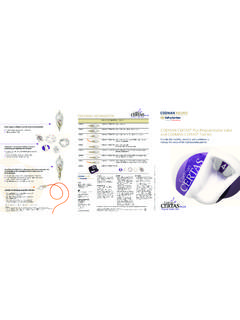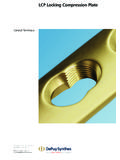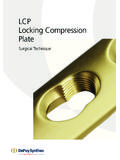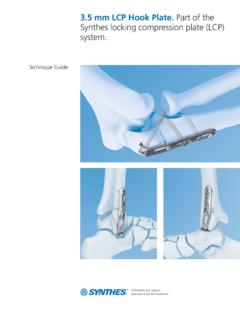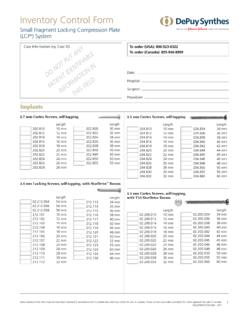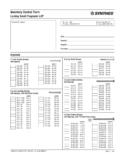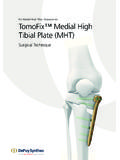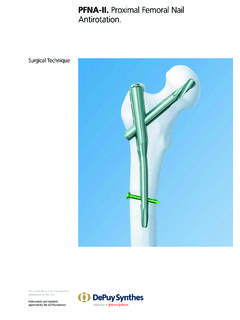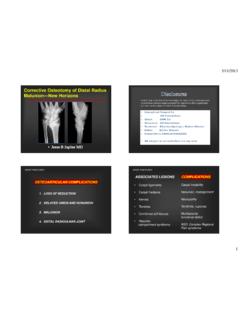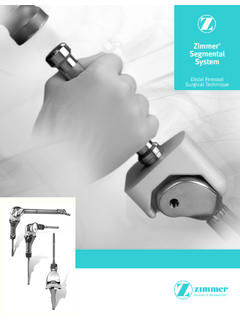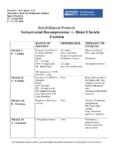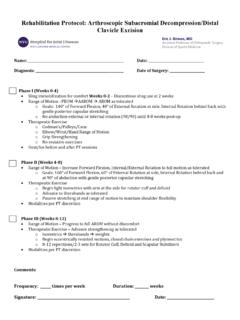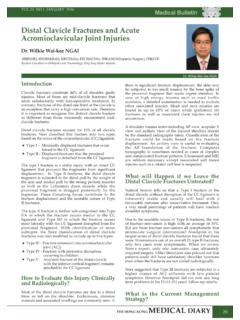Transcription of 2.4 mm LCP Distal Radius System - Limelight Networks
1 Mm LCP Distal Radius System . A comprehensive plating System to address a variety of fracture patterns. Technique Guide Table of Contents Introduction mm LCP Distal Radius System 2. AO Principles 6. Indications 7. Three-Column Theory 8. Clinical Cases 9. Surgical Technique General Technique 11. Volar Plating Surgical Technique 19. Volar Plating for Dorsally Displaced (Colles') Fractures 27. Dorsal Plating Surgical Technique 29. Postoperative Treatment 34. Implant Removal 34. Product Information Implants 35. Instruments 41. Set List 46. References 51. IMPORTANT: This device has not been evaluated for safety and compatibility in the MR environment. This device has not been tested for heating or migration in the MR environment. Image intensi er control Synthes mm LCP Distal Radius System . A comprehensive plating System to address a variety of fracture patterns.
2 A wide variety of dorsal and volar plates allows implant placement to match the individual patient anatomy and fracture pattern Three volar plate designs address both simple and complex fractures Low plate-and-screw profile and rounded plate edges minimize potential for tendon and soft tissue irritation Locking screws and pins result in a fixed-angle construct to support the articular surface, reduce the need for bone graft, and obtain fixation in osteoporotic bone Choice of lengths for each plate type*. Locking option available in all plate holes Combi holes in the locking compres- sion plates (LCP) allow locking screw fixation in the threaded section, or compression/neutralization in the nonthreaded section of the hole Available in stainless steel and titanium * For long volar plates refer to Synthes Dia-Meta Volar Distal Radius Plate Technique Guide 2 Synthes mm LCP Distal Radius System Technique Guide Volar column Distal Radius plates Volar column plates (VCP) are precon- Volar column plates can be used for toured for anatomic fit on the volar both simple and complex fracture aspect of the Distal Radius .
3 Multiple types (AO types A2, A3, B1-B3, and locking screw holes in the head of C1-C3). Plate placement is more Distal the plate provide additional fixation of than the extra-articular plate, but not the radial and intermediate columns, as Distal as the juxta-articular plate. with screw trajectories designed to address a wide variety of fracture types. Specifically, two screws are angled to capture the radial styloid and prevent rotation of these fragments. Synthes 3. mm LCP Distal Radius System Extra-articular plates Extra-articular volar plates are precon- toured for anatomic fit of the volar aspect of the Distal Radius , so that plate placement is away from the articular surface. Extra-articular volar Distal Radius plates can be used for simple intra- or extra-articular frac- tures such as AO types A2, A3, B1- B3, and C1.
4 Diverging screw angles secure the radial styloid and other Distal fragments. Undercuts on the bottom of the 5-hole head extra-articular plates facilitate contouring of the plate to match the anatomy of the Distal Radius and minimize the potential for soft tissue irritation. Juxta-articular volar plates Juxta-articular volar plates are precontoured with a complex bend designed to fit the volar surface of the Distal Radius . Juxta-articular plates may be used for more complex fractures (AO types B3, and C1-C3). Placement is as Distal as possible on the Radius . The locking holes in the head of the plate are angled 5 . proximal to the articular surface, to allow a more Distal plate placement. Undercuts on the bottom of the new images plate head facilitate contouring of the plate to match the anatomy of the Distal Radius and minimize the potential for soft tissue irritation.
5 4 Synthes mm LCP Distal Radius System Technique Guide Dorsal plates Right-angle L-plates, oblique L-plates, T-plates and straight plates are used in the dorsal two-plate technique, which provides a strong construct for complex Distal Radius fractures, avoids removal of Lister's tubercle, and decreases tendon and soft tissue irritation. Straight plates, precontoured to fit the radial column, have a notched tip that allows these plates to fit on the radial styloid adjacent to a temporary K-wire fixation. The two-plate technique of dorsal fixation of Distal Radius fractures offers increased stabilization due to the 70 90 angle between the two plates. The dorsoradial plate buttresses the radial column, and a dorsoulnar plate supports the inter- mediate column. Synthes 5. AO Principles In 1958, the AO formulated four basic principles which have become the guidelines for internal Those principles, as applied to the mm LCP Distal Radius Plates, are: Anatomic reduction Plates are designed to facilitate anatomic restoration of the articular surface, in conjunction with locking screws.
6 Multiple volar and dorsal plates, some with a precontoured anatomic design, provide fixation options for a variety of fracture patterns. Stable fixation Complex fractures may be treated according to the 3-column theory by addressing ulnar and radial fragments separately. Locking screws create a fixed-angle construct, providing angular stability. Preservation of blood supply Limited-contact plate design reduces plate-to-bone contact. Locked plates do not need close contact with the bone, which limits vascular trauma. Early, active mobilization Early mobilization per standard AO technique creates an environment for bone healing, expediting a return to optimal function. 1. M. E. M ller, M. Allg wer, R. Schneider, and H. Willenegger. Manual of Internal Fixation, 3rd Edition. Berlin: Springer-Verlag. 1991. 6 Synthes mm LCP Distal Radius System Technique Guide Indications For fixation of complex intra- and extra-articular fractures and osteotomies of the Distal Radius and other small bones.
7 Synthes 7. Three-Column Theory Three-column theory of Distal Radius fracture fixation The treatment of Distal Radius fractures should entail anatomic reconstruction of the joint surface, stable internal fixation and an early functional postoperative regimen. The Distal Radius and Distal ulna form a three-column biomechan- ical construction: Radial column Lateral side of Radius including the radial styloid and scaphoid fossa Intermediate column Medial side of Radius , including the lunate fossa and sigmoid notch Ulnar column Ulnar head, including the triangular fibrocartilage complex (TFCC) and the ulnar portion of the Distal radioulnar joint (DRUJ). Columns of the Distal Radius 8 Synthes mm LCP Distal Radius System Technique Guide Clinical Cases Case 1 Volar column plate 65-year-old female, fall Classification: A2, right hand Osteopenic, ulna styloid Preoperative Preoperative Postoperative Postoperative lateral view AP view lateral view AP view Case 2 Extra-articular plate Comminuted, dorsally displaced fracture of the Distal Radius .
8 Preoperative Preoperative Postoperative Postoperative lateral view AP view lateral view AP view Synthes 9. Clinical Cases Case 3 Juxta-articular plate A 34-year-old woman with reverse Barton fracture. Preoperative Preoperative Postoperative Postoperative lateral view AP view lateral view AP view Case 4 Dorsal plates Comminuted intra-articular fracture;. radiocarpal joint reconstruction using dorsal approach. Preoperative Preoperative Postoperative Postoperative lateral view AP view lateral view AP view 10 Synthes mm LCP Distal Radius System Technique Guide General Technique The following steps apply throughout the technique for all plates. 1. Plate contouring Instrument Bending Pin (2 required). If necessary, fine bending of the dorsal plates and Distal tabs of the juxta-articular and 5-hole head extra-articular plates may be achieved using bending pins or threaded LCP drill guides.
9 Be careful to avoid overbending and damage to plate threads. Alternative instrument Bending Pliers Bending pliers are also provided for additional plate contouring. Note: The plate holes have been designed to accept some degree of deformation. Undercuts help protect the threaded holes from distortion. Significant distortion of the locking holes reduces locking effectiveness. Synthes 11. General Technique 2. Temporary fixation with K-wires Instruments / mm Kirschner Wire, stainless steel or titanium / mm Kirschner Wire, stainless steel or titanium mm Kirschner Wire, stainless steel or titanium Threaded LCP Drill Guide, mm mm Threaded Drill Guide, short mm K-Wire Insert (for use with ). mm K-wires can be placed through the mm short threaded drill guide or threaded LCP drill guide. When using a mm K-wire, the drilling step with a mm drill bit may be omitted.
10 Mm K-wires may also be placed through the threaded LCP drill guide using the mm K-wire insert. Thread the drill guide into a locking hole and place the K-wire insert into the drill guide. Insert the K-wire. For the 6- or 7-hole head LCP volar column plate, a mm K-wire may be inserted directly through any of the dedicated K-wire holes. Note: When using the guide block for 6- or 7-hole head volar column plate, insert a K-wire. 12 Synthes mm LCP Distal Radius System Technique Guide 3 Volar Plates Screw and buttress pin insertion Use mm locking screws in the Distal portion of the dorsal or volar plates and mm locking or mm cortex screws in the shaft of dorsal and volar plates. mm cortex screws can be used only in the Combi holes in the shaft of the volar plates. mm LCP. buttress pins can be used in any mm locking hole. If a combination of locking and cortex screws is planned, a cortex screw should be used first to pull the plate to the bone.
